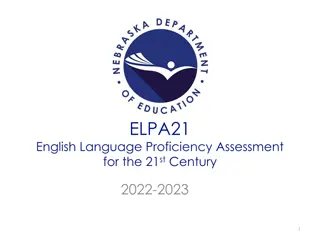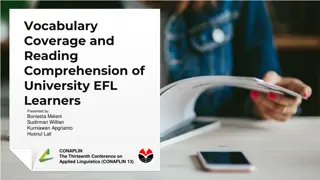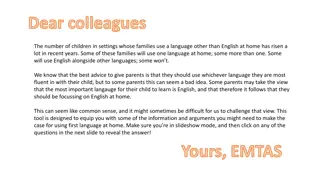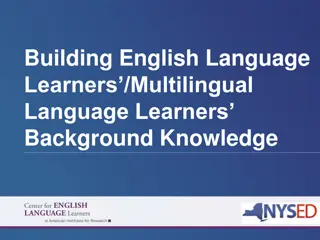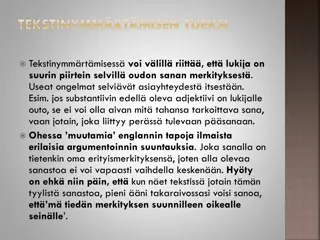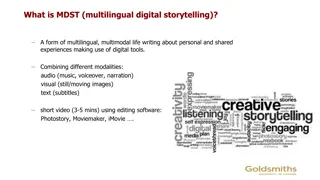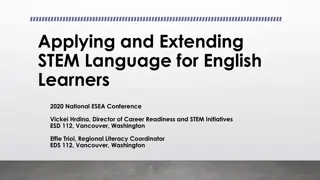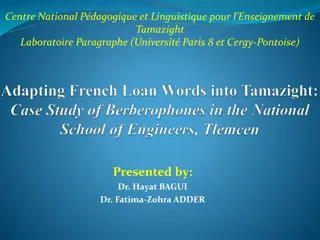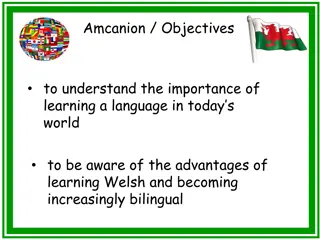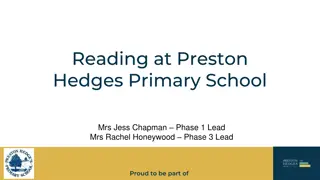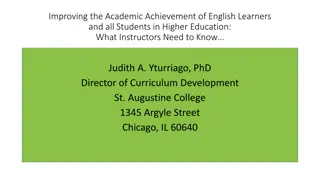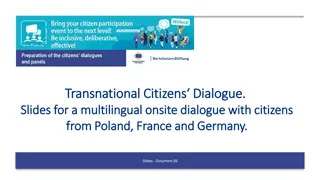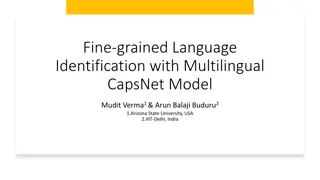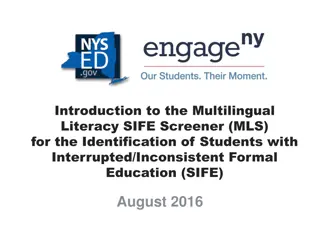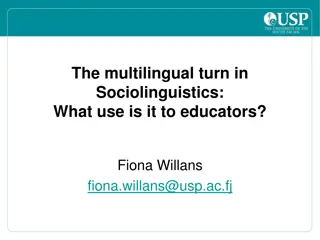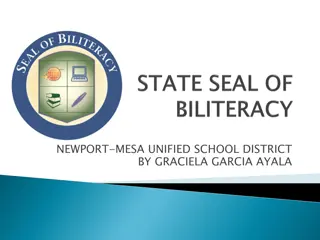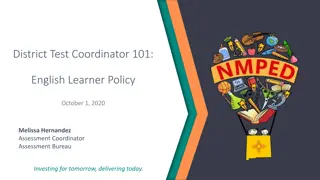Enhancing Comprehension for English Language Learners/Multilingual Language Learners
This presentation focuses on scaffolding English language arts instruction to enhance comprehension for English Language Learners (ELLs) and Multilingual Language Learners (MLLs). It covers strategies like close reading, building background knowledge, and vocabulary development. The goal is to support teachers in effectively teaching ELLs/MLLs and providing them with the necessary tools for academic success, as sponsored by the New York State Education Department Office of Bilingual Education and World Languages.
- English language learners
- Multilingual language learners
- Comprehension strategies
- Scaffolding instruction
- Close reading
Download Presentation

Please find below an Image/Link to download the presentation.
The content on the website is provided AS IS for your information and personal use only. It may not be sold, licensed, or shared on other websites without obtaining consent from the author. Download presentation by click this link. If you encounter any issues during the download, it is possible that the publisher has removed the file from their server.
E N D
Presentation Transcript
Enhancing Comprehension for English Language Learners/Multilingual Language Learners
Welcome! This is the third presentation in a series of 3 sponsored by the New York State Education Department Office of Bilingual Education and World Languages (OBEWL). The goal is to support teachers in scaffolding English language arts instruction for English language learners/Multilingual language learners (ELLs/MLLs). This presentation focuses on enhancing comprehension during close reading. The other two presentations focus on: #1 building background knowledge #2 vocabulary development 2
Welcome! Examples of lessons that use these strategies can be found in the Scaffolding Instruction for English Language Learners: Resource Guides for English Language Arts and Mathematics https://www.engageny.org/resource/scaffolding- instruction-english-language-learners-resource-guides- english-language-arts-and 3
Welcome! Ideally, you will view this presentation as part of a school- based professional learning community (PLC). This in an interactive presentation that includes several activities and partner talks. When you see the following image, pause the webinar and complete the activity or partner talk as a small group or with a partner. 4
Partner Talk Familiarize yourself with other members of your group. Share with each other the following information: What grade(s) do you teach? Approximately how many ELLs/MLLs do you serve? What are the English proficiency levels of the ELLs/MLLs that you provide services to? 5
Overview of Presentation Introduction to close reading for ELLs/MLLs Exemplar lesson Asking guiding questions Asking supplementary questions Annotating the text for key ideas and details Revisiting text for craft and structure or integration of knowledge and ideas Scaffolding responses 6
Introduction to Enhancing Comprehension During Close Reading 7
Next Generation Learning Standards Text Complexity Expectations English Language Learners (ELLs)/Multilingual Learners (MLLs) enter the school system at all grade levels, with a range of proficiency in English and varying degrees of literacy and academic competencies in their home or primary language. While building proficiency in English, ELLs/MLLs, in English as a New Language and Bilingual Education programs may demonstrate skills bilingually or transfer linguistic knowledge across languages. The eventual goal of English Language Arts (ELA) standards is to support the lifelong practices of reading, writing, speaking and listening in English. ELLs/MLLs can receive home language supports and be provided opportunities to demonstrate skills in their home or primary languages to indicate mastery of the linguistic concepts and skills embedded in the ELA standards. Throughout the standards, the use of annotation marks this concept for ELLs/MLLs. Source: http://www.nysed.gov/common/nysed/files/ nys-next-generation-ela-standards.pdf 8
What the Research Says Integrate oral and written English language instruction into content-area teaching (Baker et al., 2014, p. 6) Strategically use instructional tools such as short videos, visuals, and graphic organizers to anchor instruction and help students make sense of content Explicitly teach the content-specific academic vocabulary, as well as the general vocabulary that supports it, during content-area instruction Provide daily opportunities for students to talk about content in pairs or small groups Provide writing opportunities to extend student learning and understanding of content 9
Exemplar Lesson The Value of Sports in People s Lives 10
Its Not Just a Game! TEXT Whether you run a race, bounce a basketball, or hurl a baseball home, you do it because it s fun. Some scientists claim play is a natural instinct just like sleep. That might explain why sports are likely to be as old as humanity. Some claim sports began as a form of survival. Prehistoric man ran, jumped, and climbed for his life. Hunters separated themselves by skill, and competition flourished. Wall paintings dating from 1850 BC that depict wrestling, dancing, and acrobatics were discovered in an Egyptian tomb at Bani Hasan. The ancient Greeks revolutionized sports by holding the world s first Olympic games at Olympia in 776 BC. But it wasn t until the early nineteenth century that sports as we know them came into play. (Pardon the pun!) Modern sports such as cricket, golf, and horse racing began in England and spread to the United States, Western Europe, and the rest of the world. These sports were the models for the games we play today, including baseball and football. All organized sports, from swimming to ice hockey, are considered serious play. There are rules to obey, skills and positions to learn, and strategies to carry out. But Peter Smith, a psychology professor at Goldsmiths, University of London, and author of Understanding Children s Worlds: Children and Play (Wiley, 2009), says, Sport-like play is usually enjoyable, and done for its own sake. 11
Text Complexity Why Comprehension Can Be Challenging? 12
Text Complexity Text Complexity Triad Reader and Task Qualitative Quantitative Source: National Governors Association Center for Best Practices & Council of Chief State School Officers. (2010). Common Core State Standards for English language arts and literacy in history/social studies, science, and technical subjects. Washington, DC: Author. 13
Text Complexity Quantitative Complexity Quantitative evaluation of the text: Readability measures and other scores of text complexity. Quantitative Source: National Governors Association Center for Best Practices & Council of Chief State School Officers. (2010). Common Core State Standards for English language arts and literacy in history/social studies, science, and technical subjects. Washington, DC: Author. 14
Text Complexity Source: http://www.corestandards.org/assets/E0813_Appendix_A_New_Research_on_Text_Complexity.pdf 15
Text Complexity Lexile (http://lexile.com) Lexile text measure: Text measure is based on the semantic and syntactic complexity of a text. Lexile reader measure: Reader measure is determined using a test; measure indicates predicted ability to comprehend 75 percent of a text at this Lexile level. Many reading assessments provide information about students lexile level. El Sistema Lexile Para Leer: Matches Spanish readers and texts. 16
Text Complexity Quantitative Complexity Source: https://lexile.com/using-lexile/lexile-measures-and-the-ccssi/text-complexity-grade-bands-and-lexile-ranges/ 17
Lexile level for the text excerpt. Text Complexity Stretch Grade Band Lexile Level It s Not Just a Game! Whether you run a race, bounce a basketball, or hurl a baseball home, you do it because it s fun. Some scientists claim play is a natural instinct just like sleep. That might explain why sports are likely to be as old as humanity. Some claim sports began as a form of survival. Prehistoric man ran, jumped, and climbed for his life. Hunters separated themselves by skill, and competition flourished. Wall paintings dating from 1850 BC that depict wrestling, dancing, and acrobatics were discovered in an Egyptian tomb at Bani Hasan. The ancient Greeks revolutionized sports by holding the world s first Olympic games at Olympia in 776 BC. But it wasn t until the early nineteenth century that sports as we know them came into play. (Pardon the pun!) Modern sports such as cricket, golf, and horse racing began in England and spread to the United States, Western Europe, and the rest of the world. These sports were the models for the games we play today, including baseball and football. 1050 6 10 All organized sports, from swimming to ice hockey, are considered serious play. There are rules to obey, skills and positions to learn, and strategies to carry out. But Peter Smith, a psychology professor at Goldsmiths, University of London, and author of Understanding Children s Worlds: Children and Play (Wiley, 2009), says, Sport-like play is usually enjoyable, and done for its own sake." 18
Text Complexity Qualitative Complexity Qualitative evaluation of the text:Levels of meaning or purpose, structure, language conventionality and clarity, and knowledge demands. Qualitative Source: National Governors Association Center for Best Practices & Council of Chief State School Officers. (2010). Common Core State Standards for English language arts and literacy in history/social studies, science, and technical subjects. Washington, DC: Author. 19
Text Complexity Attributes That Make Text Challenging for All Students Lexical level Words with multiple levels of meaning Nominalization (e.g., implementation, help) Unfamiliar vocabulary Use of archaic language Sentence level Figurative language Significant use of nonstandard dialect Fisher, D., Frey, N., & Lapp, D. (2012). Text complexity: Raising rigor in reading. Newark, DE: International Reading Association. 20
Text Complexity Attributes That Make Text Challenging for All Students (continued) Discourse level Text with multiple levels of meaning Distortions in organization of text (e.g., time sequences) Specialized content knowledge required Limited use of text features and graphics Fisher, D., Frey, N., & Lapp, D. (2012). Text complexity: Raising rigor in reading. Newark, DE: International Reading 21 Association.
Text Complexity Additional Attributes That Make Text Challenging for ELLs Lexical level Greater number of unfamiliar words and phrases Connectives 22
Qualitative Complexity for ELLs/MLLs Some claim sports began as a form of survival. Prehistoric man ran, jumped, and climbed for his life. Hunters separated themselves by skill, and competition flourished. Wall paintings dating from 1850 BC that depict wrestling, dancing, and acrobatics were discovered in an Egyptian tomb at Bani Hasan. The ancient Greeks revolutionized sports by holding the world s first Olympic games at Olympia in 776 BC. But it wasn t until the early nineteenth century that sports as we know them came into play. Greater number of unfamiliar words and phrases Connectives 23
Text Complexity Additional Attributes That Make Text Challenging for ELLs/MLLs (continued) Sentence level Complex syntax Discourse level Reference chains anaphora (e.g., he, she, that, which) concepts connected with each other that are not named or are named differently Example: Wall paintings1 dating from 1850 BC that1 depict wrestling, dancing, and acrobatics were discovered in an Egyptian tomb at Bani Hasan. 24
Qualitative Complexity for ELLs/MLLs Some claim sports began as a form of survival. Prehistoric man ran, jumped, and climbed for his life. Hunters separated themselves by skill, and competition flourished. Wall paintings dating from 1850 BC that depict wrestling, dancing, and acrobatics were discovered in an Egyptian tomb at Bani Hasan. The ancient Greeks revolutionized sports by holding the world s first Olympic games at Olympia in 776 BC. But it wasn t until the early nineteenth century that sports as we know them came into play. Complex syntax Reference chains 25
Text Complexity Complexity Reader and Task Matching reader to text and task: Reader variables (such as motivation, knowledge, and experiences) and task variables (such as purpose and the complexity generated by the task and questions posed). Reader and Task Source: National Governors Association Center for Best Practices & Council of Chief State School Officers. (2010). Common Core State Standards for English language arts and literacy in history/social studies, science, and technical subjects. Washington, DC: Author. 26
Text Complexity Reader Variables Motivation: Motivate students by finding text that will interest them and by allowing them to choose text for independent reading that is at their zone of proximal development. Knowledge and experience: Enhance students ability to comprehend the text by strategically providing background information. Task Variables Some tasks require higher levels of English language proficiency. For challenging texts, make the tasks commensurate with students current proficiency levels. 27
Text Complexity Task Variables Complete standards-aligned tasks for less text, or complete fewer tasks. Name three interesting ideas you learned about sports. Choose one idea from each paragraph. Tell your partner these ideas and explain why you found them interesting. Name an interesting idea you learned about sports from the text. Tell your partner the ideas and explain why you found it interesting. Native Speaker Task ELL/MLL Task 28
Text Complexity Task Variables Provide support to help ELLs/MLLs complete grade-level tasks. Native Speaker Task Introduce the passage and have students read it independently. Chunk the text. Read the text chunk aloud, modeling proper pacing and intonation and defining unknown words. Have students work in pairs to answer supplementary questions for that chunk of text. ELL/MLL Task 29
Text Complexity: Recap Quantitative Word length, frequency, and difficulty Sentence length and complexity Text length Text cohesion Paragraph structure Qualitative Lexical level: multiple meaning words, nominalization, archaic and unfamiliar vocabulary Sentence level: figurative language, nonstandard dialects Discourse level: multiple-meaning text, organizational distortions, specialized knowledge, limited use of text features, rhetorical mode versus purpose ELLs/MLLs: unfamiliar vocabulary, connectives, complex syntax, reference chains Reader and Task Considerations Motivation Knowledge Experience 30
Partner Talk Which aspects of text complexity surprise you (if any)? How might you help ELLs/MLLs overcome the challenges associated with text complexity? 31
Multiple Readings Engage Students in Multiple Readings 32
Present Text in Smaller Sections To help ELLs/MLLs engage deeply with text, present it in small, coherent sections. Divide the text into sections that have conceptual coherence (e.g., by events, ideas, descriptions). The number of sections per lesson will depend on the level of difficulty of the text for a particular group of students. The text can be further divided into sub-sections for a given lesson. 33
Engage Students in Multiple Readings Reading for Key Ideas and Details Teacher Read Aloud: The teacher reads the first section of text aloud to demonstrate native speaker fluency. First Close Read: Students read the same section of the text in pairs or groups and answer questions focused on key ideas and details and vocabulary. Annotating for Key Ideas and Details Annotation: Students reread the section of the text and note vocabulary and details that they do not yet understand. Revisiting for Craft and Structure or Integration of Knowledge and Ideas Second Close Read: Students read the section of the text in pairs or groups and answer questions focused on craft and structure or integration of knowledge and ideas. 34
Partner Talk Do you currently present text in smaller sections? If yes, describe how you decide where to divide the text. If no, describe how you might decide this. What do you think the benefits might be of engaging students in multiple readings? 35
Reading for Key Ideas and Details 36
Reading for Key Ideas and Details Reading for Key Ideas and Details Teacher Read Aloud: The teacher reads the text aloud to demonstrate native speaker fluency. First Close Read: Students read the text in pairs or groups and answer questions focused on key ideas and details and vocabulary. Annotating for Key Ideas and Details Annotation: Students reread the text and note vocabulary and details that they do not yet understand. Revisiting for Craft and Structure or Integration of Knowledge and Ideas Second Close Read: Students read the text in pairs or groups and answer questions focused on craft and structure or integration of knowledge and ideas. 37
Anchor Standards Key Ideas and Details Read closely to determine what the text says explicitly/implicitly and make logical inferences from it; cite specific textual evidence when writing or speaking to support conclusions drawn from the text. Determine central ideas or themes of a text and analyze their development; summarize the key supporting details and ideas. Analyze how and why individuals, events, or ideas develop and interact over the course of a text. 38
Anchor Standards Vocabulary Acquisition and Use Determine or clarify the meaning of unknown and multiple-meaning words and phrases by using context clues, analyzing meaningful word parts, and consulting general and specialized reference materials, as appropriate. Comprehension and Collaboration Prepare for and participate effectively in a range of conversations and collaborations with diverse partners, express ideas clearly and persuasively, and build on those of others. Presentation of Knowledge and Ideas Present information, findings, and supporting evidence such that listeners can follow the line of reasoning. Ensure that the organization, development, and style are appropriate to task, purpose, and audience. 39
Reading for Key Ideas and Details Ask Standards-Aligned Guiding Questions Cluster Standard Generic Stem Question/Task Key Ideas and Details Standard 2: Determine central ideas or themes of a text and analyze their development; summarize the key supporting details and ideas What is the central idea of the text? What details illustrate this? Summarize the text without including any personal opinions or judgments. Name an interesting idea you learned about sports from the text. 40
ACTIVITY 1: Guiding Questions Open your handout and go to Activity 1 on page 2. Work with your partner to write a standards-aligned guiding question. Be sure your question aligns with the key ideas and details question stems (see the grade-level question stems handout for assistance). 41
EXAMPLE: Guiding Questions Ask Standards-Aligned Guiding Questions Cluster Standard Generic Stem Question Key Ideas and Details Standard 3: Analyze how and why individuals, events, and ideas develop and interact overt he course of a text. How was [individual/event/idea] introduced and portrayed in the text? How are sports related to early human survival? How did the [individual/event/idea] relate to [individual/idea/event]? 42
Reading for Key Ideas and Details Ask Standards-Aligned Supplementary Questions ELLs/MLLs may need additional, supplementary questions to help them comprehend the text. Some supplementary questions are used to help students answer guiding questions. These are sequenced. Supplementary questions can inquire about word meanings as well as larger sections of text. Make it easier for ELLs/MLLs to answer supplementary questions by Defining key words prior to asking the question Restating phrases or sentences that will help ELLs/MLLs answer the question Note that supplementary questions are text dependent! 43
Reading for Key Ideas and Details Ask Standards-Aligned Supplementary Questions Guiding question: Name an interesting idea you learned about sports from the text. Focus on important points in the text Inquire about word meanings Inquire about larger sequence of text Define key words prior to asking the question Why do we play sports? Sequence to support Text dependent What does revolutionize mean? understanding How did the Greeks revolutionize sports? Come into play means start. When did modern sports come into play? 44
ACTIVITY 2: Supplementary Questions 1. Open your handout and go to Activity 2 on page 3. 2. Work with a partner to create text-dependent supplementary questions for the guiding question you created in Activity 1. 3. Ensure that the questions are Aligned to a reading standard Text dependent Sequenced to support understanding 4. Consider incorporating strategies to make it easier for ELLs/MLLs to answer your questions. 5. Share questions and comments with the group. 45
EXAMPLE: Supplementary Questions Based? Text Guiding Question How are sports related to early human survival? Supplementary Question 1 Supplementary Question 2 Supplementary Question 3 The author says that sports are as old as humanity. What does old as humanity mean? Why may sports be as old as humanity ? What evidence is there that sports began as a form of survival? 46
Annotating the Text for Key Ideas and Details 47
Annotating the Text for Key Ideas and Details Engage Students in Multiple Readings Reading for Key Ideas and Details Teacher Read Aloud: The teacher reads the text aloud to demonstrate native speaker fluency. First Close Read: Students read the text in pairs or groups and answer questions focused on key ideas and details and vocabulary. Annotating for Key Ideas and Details Annotation: Students reread the text and note vocabulary and details that they do not yet understand. Revisiting for Craft and Structure or Integration of Knowledge and Ideas Second Close Read: Students read the text in pairs or groups and answer questions focused on craft and structure or integration of knowledge and ideas. 48
Annotating the Text for Key Ideas and Details Ask students to annotate the text after they have already participated in reading the text for key ideas and details. Students annotate the text to: Identify vocabulary they don t know Identify portions of the text they don t understand Develop questions related to portions of the text they don t understand 49
Annotating the Text for Key Ideas and Details INSTRUCTIONS FOR STUDENTS: Now read the passage once more. Start by choosing up to five words you still don t understand and write them in the spaces below. Underline sections of the text that still confuse you and prepare questions about these sections. Your teacher will help you define the words you do not know and answer the questions you have. 1) Write up to five words or phrases you still don t know: _________________________ _________________________ _________________________ _________________________ _________________________ 2) Write questions for the parts of the text you still don t understand. _______________________________________________________________________________ _______________________________________________________________________________ _______________________________________________________________________________ _______________________________________________________________________________ _______________________________________________________________________________ 50


